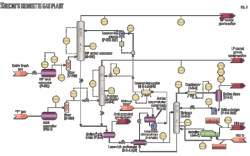A common European approach toward carbon capture and sequestration and toward developing an integrated carbon dioxide transportation network will help address CO2 emissions.
Carbon dioxide transport infrastructure will be a key component of any future carbon capture and sequestration plans. Pipelines are the most economical means of moving most sequestered CO2, based on location of the supply sources (large industrial compounds) and potential injection sites (large depleted oil and gas reservoirs, saline aquifers).
The pipeline industry is therefore preparing the first scenarios for developing carbon dioxide pipeline networks, while authorities and other organizations examine creating a standardized framework for such networks: DNV CO2PIPETRANS (OGJ, Sept. 14, 2009, p. 14) and the European Union CCS Directive proposal discussed in this article.
EU directive
In January 2008, the European Commission—the main source of legislative initiatives in the EU—advanced a proposal for a directive on the geological storage of CO2. Although different sections of previous EU legislation already addressed some aspects of CCS, this was the first initiative to integrate in one document the principles of its future development in the EU.
The proposal went through the normal cycle of public and industry consultation and was approved and published in the Official Journal of the European Union on Apr. 23, 2009, under the title Directive 2009/31/EC of the European Parliament and of the Council on the geological storage of carbon dioxide.1
The Directive also has European Economic Area relevance, meaning it can be used by the countries that are not members of the EU but are members of the EEA: Norway, Switzerland, Iceland, and Liechtenstein.
The EU Directive considers CCS a bridging technology to reduce CO2 emissions. According to the directive, and based on the EU's target of 20% reduction in greenhouse gas emissions by 2020, 7 million tonnes of carbon dioxide could be stored by 2020 and up to 160 million tonnes by 2030. CCS will be only one of the tools used in reducing greenhouse gas emissions, representing 15% of the reductions required in the Union by 2030.
Directive 2009/31/EC covers the geological storage of carbon dioxide with a total intended storage of more than 100 kilotonnes within the territory of the EU countries, their offshore exclusive economic areas, and continental shelves.
The main objectives of the EU CCS Directive are to:
- Create a regulatory framework allowing CCS to be developed and operated in an environmentally safe way.
- Define the basic rules for the safe storage and transportation of CO2.
- Propose mechanisms to encourage both public and private sector financing of the development and implementation of large-scale CCS projects and networks.
- Encourage the research and development of the most economical CCS technologies.
The directive asks member states to create conditions for open and nondiscriminatory access to CO2 transport networks and storage sites. It also requires countries to create all necessary conditions for the cross-border transportation of CO2. EU legislation relative to transporting waste materials is to be amended to exclude CO2 transported for the purpose of geological storage.
Issuing any CO2 storage permit will require a description of the transportation method. Existing EU legislation on permitting new large fossil-fuel power plants will be amended to include the economic feasibility of CO2 transportation from such a source to the potential storage sites (sinks).
CO2 drivers
Assessing the future of CO2 pipelines in Europe requires first understanding the main network development drivers. These include the development process of the pipeline network, as well as other factors having an effect such as development of enhanced oil and gas recovery—EOR, EGR—or the potential use of existing oil and gas pipeline infrastructure for future CO2 transportation infrastructure.
The implementation of CCS projects will be gradual, extending the development of a CO2 pipeline network across several stages. Relatively short point-to-point pipelines will initially link demonstration and early stage CO2 sources with the most promising storage sites in their proximity. As CCS implementation advances, some regions or countries are likely to develop hub-and-spoke pipeline networks, optimizing transportation between their domestic CO2 sources and available domestic sinks.
When CCS becomes the norm—or if the EU at some point makes it mandatory—regional networks will be linked in a pan-European pipeline network balancing the storage deficit of some regions with the excess storage capacity of other regions. Costs and problems will be more important during the local point-to-point and regional hub-and-spoke networks, while the pan-European stage will definitely offer cost benefits through network effects, while at the same time requiring management of issues such as cross-border pipelines.
Regionally focused studies have assessed the potential contribution of enhanced hydrocarbon recovery to the development of a CO2 pipeline network in Europe.2 All have concluded, contrary to the situation in regions actively producing fossil fuels such as the US, that EOR and EGR will play a limited role in Europe. Most oil and gas fields in the region will be depleted by the time CCS industry growth allows captured CO2 to reach them.
Another factor is the potential use of existing oil and gas transport infrastructure—pipelines, pumping and compressor stations, offshore platforms, etc.—for transporting captured CO2. Although feasible in some regions, such as sections of the North Sea, most of any future CO2 pipeline network will consist of new pipelines.
Timing the end of service of existing pipelines to the arrival of captured CO2 will prove difficult. Important design differences exist between gas and CO2 pipelines (pressure, corrosion protection, fracture arrestors, etc.). Infrastructure conversion investment will also be needed for pipeline refurbishment, pumping stations, platforms, etc.
Development scenarios
An impact assessment document presented in January 2008 supported the EU CCS directive. The document assessed several possible European CCS development scenarios for 2020, 2025, and 20303 and their environmental, social, and economic effects.
The document assessed the three CCS elements—capture, transportation, and storage—separately, concluding that CO2 pipelines have similar risks to those carrying natural gas and will thus be similarly regulated. Amended Directive 85/337/EC therefore requires CO2 pipelines more than 40 km long with an OD >800 mm to provide an environmental impact assessment.
This article will focus on the two CO2 pipeline network scenarios assessed by that impact assessment. In the first scenario (member states), each member state of the EU will store, as much as possible, CO2 within its borders, creating hub-and-spoke pipeline networks with almost no cross-border interconnections. This scenario foresees just 560 km of CO2 pipelines in 2025 and around 6,700 km in 2030, virtually all onshore (Fig. 1).
Since about three quarters of the CO2 capture would happen in Germany, Poland, the UK, and Belgium, most pipelines would be built in those countries. About 55% of the total length will be pipelines measuring less than 610-mm OD, with no CO2 pipelines likely more than 900 mm OD.
The second scenario (pan-European) can transport CO2 to storage areas in other countries, using the assumption that storage in depleted gas fields is more secure than storage in saline aquifers. This scenario would create a truly pan-European pipeline network, 8,080 km of pipelines in 2020, 18,700 km in 2025, and 45,580 km in 2030.
More than 80% of the 2030 network will be onshore pipelines (37,150 km), with the balance lying offshore in the North Sea, Baltic Sea, Irish Sea, and Mediterranean Sea (Fig. 2 and table).
Almost 60% of the pipelines will have an OD <610 mm, with the balance ≤900 mm. The EU gas transmission network measured about 110,000 km in 2001.
Costs
Developing a cost simulation for the above scenarios requires understanding the main cost categories, as well as the expected cost differences between building new gas and new CO2 pipelines. CO2 pipeline infrastructure requires investment in two main categories: pipelines and other infrastructure (pumping stations, offshore platforms, etc.). The main pipeline infrastructure cost categories are labor costs and pipe and other material costs, followed by land, ROW, and other costs (OGJ, Sept. 14, 2009, p. 60).
Some costs will be different for CO2 pipelines than for natural gas. Since CO2 pipelines have a high-risk of aggressive internal corrosion from small water or H2S volumes, material costs will be higher. In most cases stainless steel will be used instead of the cheaper carbon steel, or a polyethylene liner will protect the carbon steel unless a corrosion inhibitor is added directly to the CO2.
CO2 pipelines also need fracture arrestors every 300-500 m to prevent longitudinal ductile fractures caused by the slow decompression of the carbon dioxide. To reduce transportation costs, CO2 pipelines are also usually designed at higher operating pressures than gas pipelines, sometimes requiring a thicker pipe wall.
CO2 pipelines need pumping stations instead of the compressor stations used for gas pipelines. Offshore pipelines need either subsea manifolds or standard platforms to receive the CO2 before pumping it to injection wellheads (1-10/subsea manifold, 10-20/platform).
The pipeline cost estimate for onshore CO2 pipelines uses a mix of cost assumptions for both gas and CO2 pipelines drawn from the INGAA 2009 CO2 pipeline assessment4 and in the ECA/Penspen/EIHP 2007 study.5 Cost estimates for the pumping stations, etc., used cost assumptions similar to those in the INGAA study.
Offshore pipelines cost estimates used assumptions close to those used in the NOGEPA 2009 study,2 while the costs for the other transport infrastructure—platforms, pumping stations—were estimated with the BERR 2008 study's6 assumptions, particularly reuse of some existing North Sea platforms and limited use of CO2 for enhanced hydrocarbon recovery.
Offshore CO2 pipelines will be much more expensive than onshore CO2 pipelines.
Under the member-state scenario, with each state storing its CO2 emissions domestically, 70% of cumulative CO2 pipeline investment by 2030 will be for onshore pipelines. Total EU estimated cumulative pipeline investment—pipeline and other transport infrastructure—will equal $550 million by 2025 and $9.2 billion by 2030 (Fig. 3).
Under the European scenario, with CO2 storage optimized across Europe to take advantage of better storage areas (depleted oil and gas fields) and relatively interconnected national pipeline networks, only 60% of the cumulated CO2 pipeline investment by 2030 will be for onshore pipelines, as offshore storage development will be greater. The estimated cumulative pipeline investment—including pipeline and other transport infrastructure—will total $12.3 billion by 2020, $30.7 billion by 2025, and $67.7 billion by 2030 (Fig. 4). Roughly 70% of the investment will go to pipelines ≤610 mm OD (Fig. 5).
Cumulative investment in onshore pipelines will reach $4.1 billion in 2020, $13.1 billion in 2025, and $40.2 billion in 2030, while cumulative investment for offshore pipelines will be $8.2 billion by 2020, $17.6 billion by 2025, and $27.5 billion by 2030.
Subjecting these cost estimates to further sensitivity analysis can account for fluctuations in the different cost categories, but this goes beyond the scope of this article: estimating an initial cost range for CO2 transportation infrastructure.
Operating costs for pipeline networks under each scenario remain difficult to assess, with some cost categories, such as pipeline monitoring, still being discussed by the EU.
First steps
Development of a European CO2 pipeline network according to either of these scenarios could represent an excellent long-term business opportunity, generating revenue and employment for design companies, construction companies, and operating companies, as well as companies providing materials or services such as steel pipe mills, specialized coating companies, pipeline monitoring and inspection companies, etc. Using transported CO2 for enhanced hydrocarbon recovery, although limited in application, could also help sustain declining oil and gas production in Europe.
Technological barriers and the high costs of CO2 capture, however, have made large-scale adoption of CCS uncertain. Implementation of Directive 2009/31/EC into national laws could be slow as other priorities take priority, especially in the wake of the global economic crisis. The concentration of industrial CO2 sources in a limited number of EU countries could also lead to imbalanced interest in developing CCS.
New national agencies have to be created to deal with permitting and monitoring carbon storage, operating pipelines, and managing open access to them. Financing mechanisms for building new CO2 pipelines need to be identified. Lacking a CO2 pipeline history, the EU must create the whole industry from scratch, including educating the public on the perceived and real risks of CO2 pipelines.
Companies, industry associations, and national governments in Europe, however, are becoming increasingly proactive in supporting development of a European CO2 transportation infrastructure. In parallel with the CCS demonstration projects already active or under developments in the UK, France, Germany, Italy, and Norway, CO2 pipeline transportation corridors are being assessed and the first pilot pipelines are built.
Total will operate a 27-km CO2 pipeline for its Lacq CCS project in France (OGJ, June 15, 2009, p. 9). Eni and Enel plan to move CO2 captured at a power plant in Brindisi to a storage area in northern Italy. Gassco (Norway) has recently awarded 636 km of seabed survey to find the best pipeline corridors for future CO2 pipelines linking power plants in Mongstad and Kaarsto to storage areas on the Norwegian continental shelf. The list of such initiatives continues to grow.
References
- Directive 2009/31/EC of the European Parliament and of the Council of 23 April 2009 on the geological storage of carbon dioxide and amending Council Directive 85/337/EEC, European Parliament and Council Directives 2000/60/EC, 2004/35/EC, 2006/12/EC, 2008/1/EC and Regulation (EC) No 1013/2006.
- Netherlands Oil and Gas Exploration and Production Association (NOGEPA), "Potential for CO2 storage in depleted gas fields on the Netherlands Continental Shelf," 2009.
- Commission staff working document, accompanying document to the "Proposal for a Directive of the European Parliament and of the Council on the Geological Storage of Carbon Dioxide—Impact assessment," 2008.
- Interstate Natural Gas Association of America (INGAA), "Developing a Pipeline Infrastructure for CO2 Capture and Storage: Issues and Challenges," 2009.
- Economic Consulting Associates, Penspen, European Integrated Hydrogen Project, "SEE Regional Gasification Study—Draft Final Report," 2007.
- UK Department for Business, Enterprise, and Regulatory Reform (BERR), "Development of a CO2 Transport and Storage Network in the North Sea," 2008.
Vlad Popovici is marketing manager at Bredero Shaw, a division of the energy services company ShawCor. He currently manages multiple economic and strategic assessments of pipeline projects worldwide, with a focus on new pipeline applications, such as CO2 and ethanol pipelines. Popovici holds an MBA (2005) from McGill University in Montreal and has been publishing technical articles and economic analyses since 1996.
More Oil & Gas Journal Current Issue Articles
More Oil & Gas Journal Archives Issue Articles






